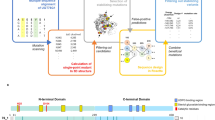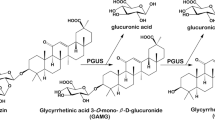Abstract
Objective
To isolate and characterize the kinetics of variants of E. coli β-glucuronidase (GUS) having altered substrate specificity.
Results
Two small combinatorial libraries of E. coli GUS variants were constructed and screened for improved activities towards the substrate p-nitrophenyl-β-d-galactoside (pNP-gal). Nine of the most active variants were purified and their kinetic parameters were determined. These variants show up to 134-fold improved kcat/KM value towards pNP-gal compared to wild-type GUS, up to 9 × 108-fold shift in specificity from p-nitrophenyl-β-d-glucuronide (pNP-glu) to pNP-gal compared to wild-type, and 103-fold increase in specificity shift compared to a previously evolved GUS variant.
Conclusions
The kinetic data collected for nine new GUS variants is invaluable for training computational protein design models that better predict amino acid substitutions which improve activity of enzyme variants having altered substrate specificity.



Similar content being viewed by others
References
Chen CP, Hsieh YT, Prijovich ZM et al (2012) ECSTASY, an adjus membrane-tethered/soluble protein expression system for the directed evolution of mammalian proteins. Protein Eng Des Sel 25:367–375
Cherry JR, Lamsa MH, Schneider P et al (1999) Directed evolution of a fungal peroxidase. Nat Biotechnol 17:379–384
Chuang HY, Suen CS, Hwang MJ, Roffler SR (2015) Toward reducing immunogenicity of enzyme replacement therapy: altering the specificity of human β-glucuronidase to compensate for α-iduronidase deficiency. Protein Eng Des Sel 28:519–529
Cirino PC, Tang Y, Takahashi K et al (2003) Global incorporation of norleucine in place of methionine in cytochrome P450 BM-3 heme domain increases peroxygenase activity. Biotechnol Bioeng 83:729–734
Farinas ET, Schwaneberg U, Glieder A, Arnold FH (2001) Directed evolution of a cytochrome P450 monooxygenase for alkane oxidation. Adv Synth Catal 343:601–606
Gallagher SR (ed) (1992) Gus protocols: using the GUS gene as a reporter of gene expression. Academic Press, Cambridge
Geddie ML, Matsumura I (2004) Rapid evolution of β-glucuronidase specificity by saturation mutagenesis of an active site loop. J Biol Chem 279:26462–26468
Gibson DG, Benders GA, Andrews-Pfannkoch C et al (2008) Complete chemical synthesis, assembly, and cloning of a Mycoplasma genitalium genome. Science 319:1215–1220
Gibson DG, Young L, Chuang R et al (2009) Enzymatic assembly of DNA molecules up to several hundred kilobases. Nat Methods 6:343–345
Grisewood MJ, Gifford NP, Pantazes RJ et al (2013) OptZyme: computational enzyme redesign using transition state analogues. PLoS ONE. doi:10.1371/journal.pone.0075358
Heckman KL, Pease LR (2007) Gene splicing and mutagenesis by PCR-driven overlap extension. Nat Protoc 2:924–932
Hilvert D (2013) Design of protein catalysts. Annu Rev Biochem 82:447–470
Kiss G, Çelebi-Ölçüm N, Moretti R et al (2013) Computational enzyme design. Angew Chem Intern Ed 52:5700–5725
Li Y, Cirino PC (2014) Recent advances in engineering proteins for biocatalysis. Biotechnol Bioeng 111:1273–1287
Matsumura I, Ellington AD (2001) In vitro evolution of β-glucuronidase into a β-galactosidase proceeds through non-specific intermediates. J Mol Biol 305:331–339
Matsumura I, Wallingford JB, Surana NK et al (1999) Directed evolution of the surface chemistry of the reporter enzyme β-glucuronidase. Nat Biotechnol 17:696–701
Pantazes RJ, Grisewood MJ, Maranas CD (2011) Recent advances in computational protein design. Curr Opin Struct Biol 21:467–472
Ray J, Scarpino V, Laing C, Haskins ME (1999) Biochemical basis of the β-glucuronidase gene defect causing canine mucopolysaccharidosis VII. J Hered 90:119–123
Reetz MT, Kahakeaw D, Lohmer R (2008) Addressing the numbers problem in directed evolution. ChemBioChem 9:1797–1804
Rowe LA, Geddie ML, Alexander OB, Matsumura I (2003) A comparison of directed evolution approaches using the β-glucuronidase model system. J Mol Biol 332:851–860
Stramm LE, Wolfe JH, Schuchman EH et al (1990) β-Glucuronidase mediated pathway essential for retinal pigment epithelial degradation of glycosaminoglycans. Disease expression and in vitro disease correction using retroviral mediated cDNA transfer. Exp Eye Res 50:521–532
Wallace BD, Wang H, Lane KT et al (2010) Alleviating cancer drug toxicity by inhibiting a bacterial enzyme. Science 330:831–835
Acknowledgements
This project was supported by the National Science Foundation (CBET Award Number 0967062).
Supporting information
Supplementary Table 1—List of primers used in this study.
Author information
Authors and Affiliations
Corresponding author
Electronic supplementary material
Below is the link to the electronic supplementary material.
Rights and permissions
About this article
Cite this article
Li, Y., Wang, Z. & Cirino, P.C. Design and characterization of new β-glucuronidase active site variants with altered substrate specificity. Biotechnol Lett 40, 111–118 (2018). https://doi.org/10.1007/s10529-017-2447-6
Received:
Accepted:
Published:
Issue Date:
DOI: https://doi.org/10.1007/s10529-017-2447-6




